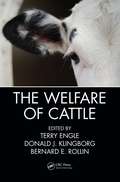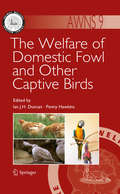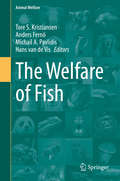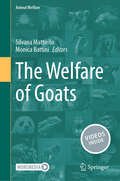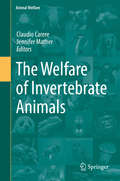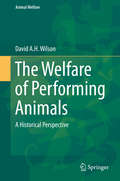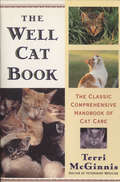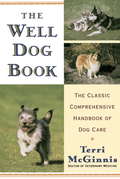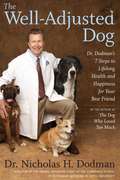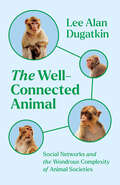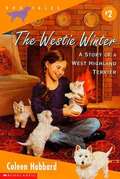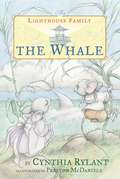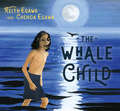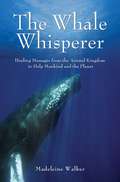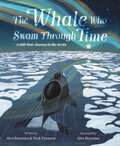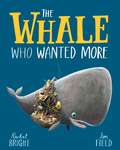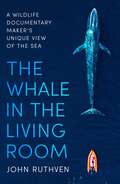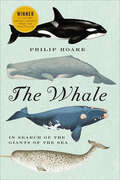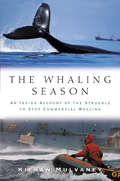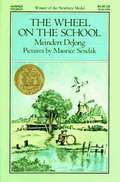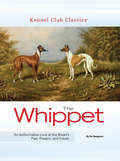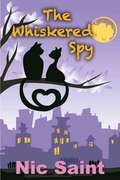- Table View
- List View
The Welfare of Cattle
by Bernard E. Rollin Terry Engle Donald J. Klingborg, DVMContains a selection of White Papers, commissioned to better inform the exploration of cattle welfare. These are prepared by notable experts in their field, to help provide factual context around selected topics that impact cattle welfare and production systems. Covers all aspects of cattle use in an accessible style, making this a must have volume for anyone interested in cattle welfare or cattle medicine. Provides an in-depth picture of the distinctive beef and dairy cattle welfare practices and issues, covering topics such as behavior, breeding and genetic manipulation, nutrition and feeding, housing and management, health and disease, and transport and slaughter. Written by acknowledged leaders in animal science, veterinary science, philosophy and animal welfare, presenting a truly multidisciplinary perspective on cattle welfare. Includes a section on understanding and managing animal welfare in both beef and dairy cattle, discussing how cattle perceive the world, animal handling and pain mitigation, and how to assure that the cows have a reasonably good life. The Welfare of Cattle offers an accurate, detailed account of the ethical and welfare concerns related to the human use of cattle. There is currently no significant book dealing with the welfare of cows, animals often seen as archetypal paradigms of 'farm animals'. Covering both beef and dairy cattle, the expert authors provide in-depth information on the husbandry roots of traditional agriculture, the replacement of this system of stewardship by an industrial model, and the resulting welfare challenges associated with industrial agriculture: feedlots, highly industrialized dairies, and slaughterhouses killing huge numbers of animals who have been transported great distances. This important book explores in detail the ways in which people who are providing care for cattle can take their first step, or their next step, toward enhancing the welfare of these animals. An extra chapter (online only) is available in the 'Downloads' tab on the left: Dairy Nutrition, by Michael Gamroth
The Welfare of Domestic Fowl and Other Captive Birds
by Ian J. Duncan Penny HawkinsThis book describes the welfare implications of keeping wild and domesticated birds in captivity. The environmental and social requirements of various avian species are discussed and suggestions made for appropriate housing and management techniques. Particular attention is paid to human-bird interactions and their impact on the behaviour and welfare of the birds involved. Training methods for companion birds are also described. Possible future trends in keeping birds in captivity are discussed in relation to evolving laws and codes for both wild and domesticated birds and in the light of developing ethical attitudes to animals. The book will be invaluable to all those who keep birds including poultry farmers, pet owners, and managers and caretakers of birds kept in laboratories, zoos, wildlife aviaries, and rehabilitation centres. It will also be of great interest to poultry production, zoology, wildlife and veterinary students.
The Welfare of Farmed Ratites
by Irek Malecki Christine Lunam Phil GlatzThis volume reviews, for the first time, the broad range of issues that affect the welfare of commercially farmed ratites. Although ratites incorporate several families of flightless birds this book focuses on the most commonly farmed ratites, the ostrich, emu and rhea. The readers are taken on a journey through all sectors of the industry, which include breeding, incubation, hatching, brooding, rearing, growth, transport and processing, with an emphasis on husbandry and management protocols that can impact bird welfare and health. Also discussed is the structure and sensory innervation of the skin and digits of the birds, and the potential welfare implications of industry practices on these structures. Each chapter in this volume focuses on a particular aspect of the commercial farming of ratites with contributing authors from a broad range of disciplines.
The Welfare of Fish (Animal Welfare #20)
by Tore S. Kristiansen Anders Fernö Michail A. Pavlidis Hans van de VisThis book investigates how fish experience their lives, their amazing senses and abilities, and how human actions impact their quality of life. The authors examine the concept of fish welfare and the scientific knowledge behind the inclusion of fish within the moral circle, and how this knowledge can change the way we treat fish in the future. In many countries fish are already protected by animal welfare legislation in the same way as mammals, but in practice there is still a major gap between how we ethically view these groups and how we actually treat them. The poor treatment of fish represents a massive animal welfare problem in aquaculture and fisheries, both in terms of the number of animals affected and the severity of the welfare issues. Thanks to its interdisciplinary scope, this thought-provoking book appeals to professionals, academics and students in the fields of animal welfare, cognition and physiology, as well as fisheries and aquaculture management.
The Welfare of Goats (Animal Welfare #25)
by Silvana Mattiello Monica BattiniThis book focuses exclusively on the welfare of goats, which have peculiar behavioral characteristics and needs, and distinct individual personalities. Despite the many differences between goats and sheep, welfare and health issues of small ruminants have often been addressed together. Goats are extremely adaptable, now widespread and farmed all over the world. Usually bred for economic purposes (milk, meat and/or fibre), goats are also occasionally kept as pet animals, in educational farms, in zoos or for animal-assisted therapy. This wide range of conditions may elicit different challenges for their welfare. Readers of this volume are introduced to the goat species, starting from its origin and domestication process, and presentation of its natural behaviour and characteristics, including recent data on goats’ ability to communicate, cognition capabilities and personality. Knowledge of these features is indispensable to allow a welfare-friendly approach to goat management. The authors then address all relevant aspects of goat welfare, covering issues related to housing, feeding, painful procedures and end-of-life management, with special emphasis on welfare challenges in adverse environments. An additional chapter is dedicated to the main health problems that can jeopardize goats’ welfare. Finally, this volume highlights the latest research to on-farm welfare assessment with indicators and protocols for evaluation. This work will appeal to scholars of animal welfare science and biology, stakeholders in the livestock industry, as well as experts in goat-assisted interventions and pet owners. Video and audio files enrich the reading experience and can also be played from the print book using the free Springer Nature More Media app.
The Welfare of Invertebrate Animals (Animal Welfare #18)
by Jennifer Mather Claudio CarereThis book is devoted to the welfare of invertebrates, which make up 99% of animal species on earth. Addressing animal welfare, we do not often think of invertebrates; in fact we seldom consider them to be deserving of welfare evaluation. And yet we should. Welfare is a broad concern for any animal that we house, control or utilize – and we utilize invertebrates a lot. The Authors start with an emphasis on the values of non-vertebrate animals and discuss the need for a book on the present topic. The following chapters focus on specific taxa, tackling questions that are most appropriate to each one. What is pain in crustaceans, and how might we prevent it? How do we ensure that octopuses are not bored? What do bees need to thrive, pollinate our plants and give us honey? Since invertebrates have distinct personalities and some social animals have group personalities, how do we consider this? And, as in the European Union’s application of welfare consideration to cephalopods, how do the practical regulatory issues play out?We have previously relegated invertebrates to the category ‘things’ and did not worry about their treatment. New research suggest that some invertebrates such as cephalopods and crustaceans can have pain and suffering, might also have consciousness and awareness. Also, good welfare is going to mean different things to spiders, bees, corals, etc. This book is taking animal welfare in a very different direction. Academics and students of animal welfare science, those who keep invertebrates for scientific research or in service to the goals of humans, as well as philosophers will find this work thought-provoking, instructive and informative.
The Welfare of Performing Animals
by David A. H. WilsonThis timely book describes and analyses a neglected area of the history of concern for animal welfare, discussing the ends and means of the capture, transport, housing and training of performing animals, as well as the role of pressure groups, politics, the press and vested interests. It examines primary source material of considerable interdisciplinary interest, and addresses the influence of scientific and veterinary opinion and the effectiveness of proposals for supervisory legislation, noting the current international status and characteristics of present-day practice within the commercial sector. Animal performance has a long history, and at the beginning of the twentieth century this aspect of popular entertainment became the subject not just of a major public controversy but also of prolonged British parliamentary attention to animal welfare. Following an assessment of the use of trained animals in the more distant historical past, the book charts the emergence of criticism and analyses the arguments and evidence used by the opponents and proponents in Britain from the early twentieth century to the present, noting comparable events in the United States and elsewhere.
The Well Cat Book: The Classic Comprehensive Handbook of Cat Care
by Terri McginnisFeaturing sections on daily care, preventive medicine, and training, The Well Cat Book teaches cat owners how to detect signs of illness, diagnose problems, and begin home treatment--thereby avoiding expensive and often unnecessary trips to the vet. Includes over 100 illustrations and step-by-step instructions.From the Trade Paperback edition.
The Well Dog Book
by Terri McginnisWritten by the same experienced veterinarian responsible for the popular The Well Cat Book, this thoroughly revised and updated reference gives dog owners the skill, confidence, and knowledge they need to raise a healthy pet. Special sections on emergency first aid, breeding and pregnancy, care of puppies are included. 100+ illustrations.From the Trade Paperback edition.
The Well-Adjusted Dog: Dr. Dodman's 7 Steps to Lifelong Health and Happiness for Your Best Friend
by Dr. Nicholas H. DodmanOne of the greatest myths in dog ownership is that once a puppy is housetrained and has graduated from a puppy training class, an owner’s work is done. In fact, that work is just beginning.Drawing on some twenty-five years of clinical experience, Dr.Dodman offers what he calls "continuing education" for dogs and their owners. You will discover • how much exercise your dog really needs (and why) • how diet can affect behavior • how to communicate clearly with your dog and understand dog body language • how to lead your dog, not dominate him • how to optimize your dog’s environment • how to address medical problems that might underlie unwanted behavior Dr.Dodman’s comprehensive, seven-step approach takes on the whole dog—his health, behavior, and environment—and lays the groundwork for the proper care and training of your best friend, for life.
The Well-Connected Animal: Social Networks and the Wondrous Complexity of Animal Societies
by Lee Alan DugatkinAn engaging exploration of the wondrous social webs that permeate life in animal societies around the world. It’s all about who you know. Whether vampire bats sharing blood meals for survival, field crickets remembering champion fighters, macaque monkeys forming grooming pacts after a deadly hurricane, or great tit birds learning the best way to steal milk—it pays to be well connected. In this tour of the animal kingdom, evolutionary biologist Lee Alan Dugatkin reveals a new field of study, uncovering social networks that existed long before the dawn of human social media. He accessibly describes the latest findings from animal behavior, evolution, computer science, psychology, anthropology, genetics, and neurobiology, and incorporates interviews and insights from researchers he finds swimming with manta rays, avoiding pigeon poop, and stopping monkeys from stealing iPads. With Dugatkin as our guide, we investigate social networks in giraffes, elephants, kangaroos, Tasmanian devils, whales, bats, and more. From animal networks in Australia and Asia to Africa, Europe, and the Americas, The Well-Connected Animal is an eye-opening exposé of wild friends, enemies, and everything in between.
The Westie Winter: A Story of a West Highland Terrier (Dog Tales #2)
by Coleen Hubbard[From the back cover:] Who could say no to a puppy? Every Christmas, Kelly asks her parents for a puppy. But she never gets one. This year Kelly has a great idea. She'll get a puppy for somebody who loves dogs as much as she does -- her Grandpa Dunc, who has just moved in with Kelly's family. Kelly meets a breeder and picks the perfect puppy on her own. But suddenly Grandpa Dune starts acting strange. Could the puppy present be all wrong? Book jacket. If you love dogs, Bookshare has more books in the Dog Tales series for you. Check out #1 The Golden Year: A Story of a Golden Retriever, #3 Mountain Dog Rescue: A Story of a Bernese Mountain Dog, and #4 The Great Spaniel Escape.
The Whale (The Lighthouse Family)
by Cynthia Rylant Preston McdanielsIn this Lighthouse Family adventure, Whistler and Lila help to reunite a baby beluga whale with his mother.Pandora, Seabold, Whistler, Lila, and Tiny have all been enjoying the love and comfort that being a family brings. It is a comfort they are unexpectedly reminded of when Whistler and Lila hear the cries of a lonely baby beluga whale named Sebastian. When they learn that he has lost his mama, the Lighthouse Family, with the help of a cranky but noble old cormorant named Huck, does all it can to bring Sebastian and his mother together again.
The Whale Child
by Keith Egawa Chenoa EgawaAn inspiring middle-grade chapter book that introduces young readers to the environmental challenges facing the planet through the eyes of Coast Salish characters and authors."You have family on land as you do in the sea. . . being a caretaker of the earth begins with taking care of the water that all life depends on."Shiny is a whale child. One day his mother teaches him about the harm facing the world's oceans because of human carelessness. Shiny agrees to be turned into a boy by the ocean's water spirit so he can visit the land and alert people to these dangers. He meets Alex, a young Coast Salish girl who learns from Shiny that the living spirit of water exists in everything--glaciers, rivers, oceans, rain, plants, and all living creatures. Together the two travel the earth, confronting the realities of a planet threatened by an uncertain future. Inspired by Shiny's hope, humor, and wisdom, Alex makes the promise to become a teacher for future generations. She realizes that the timeless Indigenous value of environmental stewardship is needed now more than ever and that we must all stand up on behalf of Mother Earth. Written and illustrated by Indigenous authors Keith Egawa and Chenoa Egawa, The Whale Child introduces children ages 7 to 12 to existing environmental issues with a message of hope, education, sharing, and action. Ideal for middle-grade readers who are beginning to read chapter books on their own, this book also includes resources for students and teachers to facilitate learning about Pacific Northwest Indigenous cultures and the environment.
The Whale Watch (Fountas & Pinnell Classroom, Guided Reading)
by Judy Schmauss Wes LoweNIMAC-sourced textbook. Whale Watching. Would you like to go whale watching? You might have fun. You might even get a surprise!
The Whale Whisperer
by Madeleine WalkerGoing beyond the standard pet communication book, this adventure delivers messages from many different wild and sacred animal species. Voices of the white buffalo, the humpback whale, the white lions of Timbavati South Africa, orcas, and bears all speak through the author, who embarked on a spiritual journey across several continents in search of this wisdom from animals. In turns moving, empowering, and entertaining, it includes practical ways to implement the animal knowledge, conveying vital messages to help save humanity and the natural world.
The Whale Who Swam Through Time: A Two-Hundred-Year Journey in the Arctic
by Nick Pyenson Alex BoersmaThis sweeping nonfiction picture book The Whale Who Swam Through Time explores the 200-year lifespan of a bowhead whale and the changing environment that surrounds her.Almost 200 years ago . . .Our journey begins with the birth of a bowhead whale, the longest-living mammal in the world. Over the course of her life in the Arctic, the bowhead whale witnesses many changes: from an era of peace and solitude to one of oil rigs and cruise liners.With gorgeous, detailed, and striking illustrations, this well researched and thoughtfully curated nonfiction story captures the magic and beauty of the natural world, while also providing a thoughtful account of how humans have impacted our changing ecosystems and a call-to-action for protecting the environment.
The Whale Who Wanted More
by Rachel BrightA stunning undersea tale of friendship, community and discovery from the bestselling creators of The Lion Inside.Under glittering waves of a vast ocean blue, a beautiful world is hidden from view.And there, in the cool and the quiet of the deep, a great, gentle giant was stirring from sleep . . .Humphrey the whale is on a quest: to find the one perfect object that will make him feel complete. He roams far and wide, gathering endless undersea treasure as he goes. Yet, no matter how many goodies he accumulates, Humphrey still doesn't feel content. Could it be friendship, not possessions, that will really make Humphrey's heart sing?A sparkling rhyming tale that encourages sharing and kindness, this heartwarming story of friendship is perfect for reading aloud.
The Whale in the Living Room
by John RuthvenThe Whale in the Living Room follows the thrilling adventures of award-winning wildlife documentary producer, John Ruthven, on a journey of discovery - by turns memorable, touching and often funny -that has helped the undersea world flow into countless living rooms to reveal many of our ocean's mysteries.John is the only producer to have worked on both Blue Planet and Blue Planet II, presented by David Attenborough, in total making nearly fifty ocean films, including episodes of Discovery Shark Week, expedition films for National Geographic and coral conservation documentaries for PBS. With innovative technology he has helped capture unique images of a sperm whale mother and calf, pictures of glowing creatures half a mile deep, and grey reef sharks hunting by the light of the moon. We swim with him through blue lagoons, dive into the abyss to encounter new life forms, and experience everything from the danger of getting lost at sea to the sadness of finding a starving whale with a fishing net caught in its mouth. Through each remarkable adventure, John gives insight into what we currently know about the ocean, and our whole blue planet, revealing that the sea really is the 'saltwater country' the Yolngu people of Australia know it to be - a place with as many unique destinations in water as on land.John's book also explores why we have remained largely blind to the pollution in our oceans until recently and charts how plastic 'went wild' in the sea, to understand how we might begin to clear up the mess.
The Whale in the Living Room: A Wildlife Documentary Maker's Unique View of the Sea
by John RuthvenThe Whale in the Living Room follows the thrilling adventures of award-winning wildlife documentary producer, John Ruthven, on a journey of discovery - by turns memorable, touching and often funny -that has helped the undersea world flow into countless living rooms to reveal many of our ocean's mysteries.John is the only producer to have worked on both Blue Planet and Blue Planet II, presented by David Attenborough, in total making nearly fifty ocean films, including episodes of Discovery Shark Week, expedition films for National Geographic and coral conservation documentaries for PBS. With innovative technology he has helped capture unique images of a sperm whale mother and calf, pictures of glowing creatures half a mile deep, and grey reef sharks hunting by the light of the moon. We swim with him through blue lagoons, dive into the abyss to encounter new life forms, and experience everything from the danger of getting lost at sea to the sadness of finding a starving whale with a fishing net caught in its mouth. Through each remarkable adventure, John gives insight into what we currently know about the ocean, and our whole blue planet, revealing that the sea really is the 'saltwater country' the Yolngu people of Australia know it to be - a place with as many unique destinations in water as on land.John's book also explores why we have remained largely blind to the pollution in our oceans until recently and charts how plastic 'went wild' in the sea, to understand how we might begin to clear up the mess.
The Whale: In Search of the Giants of the Sea
by Philip HoareA travelogue through the history, literature, and lore of the remarkable mammals that we long have been fascinated with, from Moby-Dick to Free Willy.From his childhood fascination with the gigantic Natural History Museum model of a blue whale, to his abiding love of Moby-Dick, to his adult encounters with the living animals in the Atlantic Ocean, the acclaimed writer Philip Hoare has been obsessed with whales. The Whale is his unforgettable and moving attempt to explain why these strange and beautiful animals exert such a powerful hold on our imagination.Praise for The WhaleWinner of the Samuel Johnson Prize for Non-Fiction“This tour de force is a sensuous biography of the great mammals that range on and under Earth’s oceans.” —Publishers Weekly, starred review“The Whale is part cultural study, part travelogue, as Hoare traces the footsteps of Herman Melville from New York to New Bedford and Nantucket . . . [and] digresses on our abuses of the whale and the devastations of the whaling industry.” —Boston Globe“One of the most sublime reading experiences you’ll have this year.” —NPR’S All Things Considered
The Whaling Season: An Inside Account Of The Struggle To Stop Commercial Whaling
by Kieran MulvaneyDespite a decades-long international moratorium on commercial whaling, one fleet has continued to hunt and kill whales in the waters surrounding Antarctica. Refusing to let this defiance go unchallenged, the environmental organization Greenpeace began dispatching expeditions to the region in an effort to intercept the whalers and use nonviolent means to stop their lethal practice.Over the past decade, Kieran Mulvaney led four such expeditions as a campaigner and coordinator. In The Whaling Season, he recounts those voyages in all their drama, disappointments, strain, and elation, giving readers a behind-the-scenes look at the hazards and triumphs of life as an environmental activist on the high seas. The author also explores the larger struggles underlying the expeditions, drawing on the history of commercial whaling and Antarctic exploration, the development of Greenpeace, and broader scientific and political efforts to conserve marine life. He presents a rich portrait of the current struggles and makes an impassioned plea for protection of some of the world's most spectacular creatures.For armchair adventurers, polar enthusiasts, and anyone concerned about marine conservation and continued hunting of the world's whales, The Whaling Season is an engrossing and informative tale of adventure set in one of the Earth's last great wilderness areas."
The Wheel on the School
by Meindert DejongWhy do the storks no longer come to the little Dutch fishing village of Shora to nest? It was Lina, one of the six schoolchildren who first asked the question, and she set the others to wondering. And sometimes when you begin to wonder, you begin to make things happen. So the children set out to bring the storks back to Shora. The force of their vision put the whole village to work until at last the dream began to come true.<P><P> Winner, 1955 Newbery Medal
The Whippet
by Bo BengtsonFifth in the Kennel Club Classics breed series, The Whippet, written by renowned Whippet breeder, judge and historian Bo Bengtson, is the bible on the Whippet, one of the world's most popular and beloved purebred dogs. This book's detailed chapters on everything from the history of the breed to the breed's accomplishments in dog shows around world to the Whippet's participation in racing and coursing events make it the most important and beautiful book ever published on the Whippet. With hundreds of vintage and modern photographs, this book is a must-have for every whippet owner.
The Whiskered Spy
by Nic SaintWhen Tommy the cat witnesses a murder taking place right beneath his favorite elm tree, at first he’s not too worried. After all, humans will do these things, and as long as his own human keeps the kibble and the milk coming, life goes on. But when the murdered woman’s ghost comes haunting him and accuses him of gross negligence by not interfering when he had the chance, things definitely take a turn for the mysterious.
